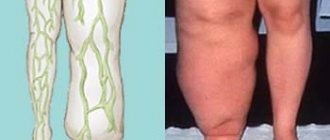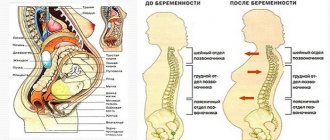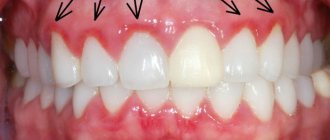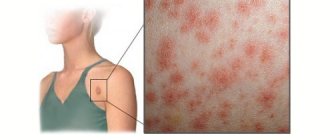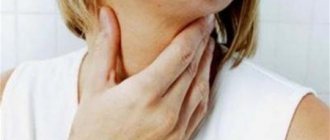Causes of endemic goiter
Iodine deficiency
Doctors call iodine deficiency the main cause of the development of endemic goiter (up to 95% of cases). Chronic microelement deficiency triggers compensatory mechanisms in cells. The gland enlarges to capture more iodine, which is necessary for the synthesis of the hormones T3 and T4.
There are two types of iodine deficiency:
- absolute – develops against the background of low iodine content in food and water;
- relative – develops as a result of diseases, congenital pathologies of the thyroid gland.
In 15% of cases, endemic goiter is associated with other causes.
Genetic factor
The risk of developing goiter increases in patients with a hereditary predisposition to thyroid diseases. Pathology can develop against the background of genetic abnormalities that disrupt the production of thyroid hormones.
Habitat
A clear relationship has been established between the development of endemic thyroid goiter and the environment in the area of human residence. An increased content of urochrome, nitrates, calcium, and humic substances in water makes it difficult to absorb iodine in the body. Long-term residence in such areas contributes to the development of goiter. Similar processes in iron are caused by a lack of molybdenum, manganese, copper, zinc, selenium, cobalt, as a result of which the activity of enzymes responsible for the synthesis of hormones decreases.
Immunity disorders
The cause of endemic goiter can be a violation of cellular immunity and the synthesis of abnormal immunoglobulins. Defective proteins trigger mechanisms in cells to produce antibodies against healthy gland tissue.
Treatment
Since the cause of the disease is a lack of iodine, it is treated with products containing this element. It is also necessary to adjust the diet - exclude goitrogenic foods from it (turnips, Brussels sprouts, radishes, beans, rutabaga, rapeseed) and increase the amount of food rich in iodine (seafood, seaweed, nuts, seeds, etc.).
If diffuse or nodular endemic goiter is accompanied by hormonal problems, temporary replacement therapy is necessary.
Traditional medicine can successfully cope with all these tasks. There are many plants with phytohormones that improve the functioning of the thyroid gland, but are not harmful to the body. And, of course, we will offer you natural products containing iodine. When used regularly, they reduce the size of the goiter and eliminate all symptoms associated with this disease.
Laminaria slates
Laminaria slates are sold in pharmacies. This is a completely natural product that is recommended by herbalists to increase the iodine content in the blood. Adults should eat 1 teaspoon of this product with water before going to bed. For children, the dosage is reduced by 2-3 times. Laminaria can be taken for a long time, it does not accumulate in the body and has no side effects.
Dream juice
In the spring-summer period, when the tree is growing, treat it with the juice of this plant. It is enough to take a tablespoon a day to replenish iodine deficiency. Children are given ½-1 teaspoon.
You can preserve the juice for the winter. To do this, strain it through a nylon cloth and mix with the same amount of medical glycerin. Pour into a glass bottle and store in the refrigerator. Since the juice is diluted, the dosage in this case is doubled.
Infusion of apricots
Treatment can also be carried out using dried apricot fruits. To do this, soak 50 g of crushed fruits in 500 ml of hot water overnight and soak until the morning. In the morning, divide the compote into several servings and drink throughout the day, and eat the fruit. Do this every day until you notice positive results.
Compote can be drunk by both adults and children.
Goiter herb
The very name of this plant suggests that it helps with goiter. The dry herb is brewed in a cup of boiling water instead of tea and drunk three times a day. For a glass of boiling water you will need about a teaspoon of goiter herb.
Dandelion roots
Products based on dandelion roots help a lot. They are dug up in the fall, when the plant has stopped blooming.
Preparation of the decoction: take 3 cups of water per tablespoon of crushed roots, boil it all over medium heat for 5 minutes, leave for half an hour and filter. Adults take a glass of decoction every time after a meal, children – ½\1/4 glass. Courses of treatment last 2-3 months and can be repeated.
Adults can also make an alcohol extract from the roots. To do this, mix 20 g of dry plant, 100 ml of glycerin and 100 ml of medical alcohol. All this needs to be infused for 3 weeks, then strained and taken half a teaspoon twice a day.
Common cocklebur
This plant can only be treated by adults. It is best to drink juice from it - 30 drops once a day. During the cold season, when there is no access to fresh cocklebur, prepare an infusion of 1 dessert spoon of dry herb and a glass of boiling water. Drink 1/3 cup of infusion three times a day.
Black currant flowers
Belarusian healers are treated with tea from black currant flowers. You can prepare a drink of any consistency; an overdose is impossible. In addition, black currants are allowed even for small children. You can add honey to tea - by the way, it contains iodine.
Raw potato juice
Raw potatoes are one of the leaders in iodine content, so they are highly recommended for goiter. Make juice from it and drink 2 tablespoons of the drink three times a day.
Clinical forms of endemic goiter
According to the type of tissue damage, endemic goiter is:
- Diffuse. The thyroid gland grows evenly. Upon palpation, no nodes are detected in the tissues. Using ultrasound diagnostics, the doctor determines the homogeneous structure of the goiter and a significant enlargement of the thyroid gland.
- Nodal. The tissue increases unevenly with the formation of focal compactions with the capsule. In endemic goiter, the nodes can be single or multiple.
- Mixed. Against the background of diffuse changes in the gland, one or several nodes form. The tissues grow strongly and have a heterogeneous structure.
According to the location of the pathology, endemic goiter is:
- unilateral – the tissue of one lobe of the gland is affected;
- bilateral - both lobes are affected.
According to the function of the thyroid gland, endemic goiter is:
- euthyroid (hormone levels are normal) – develops with minor iodine deficiency, often diagnosed in adolescents, pregnant and lactating women; euthyroid goiter may have symptoms of hypothyroidism;
- hyperthyroid (hormone levels are increased);
- hypothyroid (hormone levels are reduced).
The most common endemic goiter is the euthyroid type.
Treatment of the disease
Treatment of endemic goiter involves a complex of the following measures:
- drug therapy;
- surgical treatment (as prescribed);
- radionuclide treatment (as prescribed);
- diet;
- adherence to daily routine;
- use of traditional medicine (as prescribed).
Conservative treatment involves taking the following medications (if such a disease is present):
- L-Thyroxine;
- Triiodothyronine.
The duration of treatment is always determined by the endocrinologist. In mild cases, treatment lasts an average of 6-12 months, followed by regular monitoring of the size of the thyroid gland.
Indications for surgical treatment are:
- severe increase in size of the thyroid gland;
- goiter relapse;
- autonomous adenoma.
In the absence of a malignant process, partial resection of the thyroid gland is performed during surgery. If the development of a malignant process is detected, they resort to subtotal resection or removal of the thyroid gland.
Radionuclide therapy is used in rare cases when the effect of conservative and surgical treatment is not observed. This method slows down cell division and stops the growth of the thyroid gland.
Diet is a prerequisite for obtaining the maximum result from treatment, since most often diffuse endemic goiter occurs due to unprofitable intake of iodine in the human body.
Nutrition for endemic goiter should include:
- baked turkey fillet;
- prunes;
- cranberry;
- cod;
- shrimps;
- tuna;
- dried kelp.
List of foods that must be excluded from the diet when treating pathology:
- broccoli;
- White cabbage;
- turnip;
- radish;
- lettuce leaves;
- corn;
- beans;
- cauliflower.
Clinical recommendations for creating a comfortable regimen when treating pathology:
- limit physical exercise;
- eliminate psycho-emotional shocks;
- prevent sudden changes in climate conditions;
- limit long airplane flights;
- get rid of bad habits.
Herbal medicine for endemic goiter is quite varied, and in individual situations, the doctor may prescribe the use of one of the following remedies:
- drink half a glass of potato juice half an hour before your first meal;
- mince chokeberry with sugar, take a teaspoon 3 times a day;
- take seaweed powder one teaspoon at night every day;
- wipe the neck and area of the thyroid gland with oak bark.
Degrees of endemic goiter
Depending on the volume of the goiter and the severity of symptoms, 6 degrees of the disease are distinguished - from 0 to 5:
- Zero. The thyroid gland is not enlarged; upon palpation, the doctor does not detect any nodes or growths. There are no symptoms of endemic goiter.
- First. Endemic goiter is felt when the gland is palpated during swallowing.
- Second. The doctor determines the pathology with ordinary palpation.
- Third. An enlarged thyroid gland is noticeable visually.
- Fourth. The goiter grows so much that it disrupts the shape of the neck and apparently protrudes beyond its contours.
- Fifth. Signs of compression of the trachea, esophagus, and blood vessels appear.
Prevention
To prevent the appearance of endemic goiter, it is enough to consume foods rich in iodine. The use of iodized salt is recommended.
Iodomarin or Antistrumin is recommended for use by everyone who is at risk:
- preschoolers, school-age children;
- all people living in iodine-deficient regions;
- all pregnant women;
- women who are breastfeeding.
Preventive measures help prevent the development of endemic goiter and prevent complications.
To prevent the appearance of endemic goiter, it is enough to consume foods rich in iodine.
Symptoms of endemic goiter
The disease at an early stage may not have pronounced manifestations, except for an enlarged gland. The patient complains of feeling unwell only after physical activity.
As the goiter grows, characteristic signs of compression and metabolic disorders appear:
- difficulty swallowing and breathing;
- feeling of a lump, pressure in the neck, especially when lying down;
- attacks of coughing, choking;
- dilation of blood vessels in the neck and chest due to poor circulation;
- a feeling of tension in the head that increases when bending over;
- puffiness of the face;
- formation of a “goitrous heart” - enlargement of the right chambers of the heart;
- drowsiness;
- increased blood pressure;
- dry skin, hair, nails;
- hoarseness of voice.
Women with endemic goiter are often found to have mastopathy, fibroids, reproductive dysfunction, even infertility. The development of the disease during pregnancy can lead to miscarriage.
In childhood, patients experience arrhythmia, growth retardation, and decreased immunity. If iodine deficiency in a child is congenital, and endemic goiter is combined with poor nutrition and a low standard of living, then severe hypothyroidism may develop. Thyroid gland dysfunction causes dementia (endemic cretinism), deafness, speech disorders, and pathologies in the development of the musculoskeletal system.
Symptoms of the disease
The disease is considered multifactorial, since in addition to the lack of iodine in the patient’s body, some role in its development is assigned to genetic factors.
With this pathology, the following clinical manifestations are observed:
- decreased ability to work;
- the appearance of headache;
- discomfort in the chest area;
- noticeable enlargement of the thyroid gland;
- disruption of the heart;
- dry cough;
- attacks of suffocation;
- breathing problems;
- transition to malignant neoplasm;
- hemorrhage of the thyroid gland.
Endemic goiter in children is pronounced. Most often it is complicated in childhood by disruption of the central nervous system, inhibition of physical and intellectual development, and the development of endemic cretinism.
In a pregnant woman, diffuse endemic goiter can cause miscarriage or spontaneous abortion.
Complications of endemic goiter
Negative consequences occur when the thyroid tissue grows excessively and in the absence of treatment. The goiter begins to compress the organs and blood vessels of the neck.
Various complications arise:
- persistent dry cough;
- puffiness of the neck and head;
- hoarse voice;
- sore throat when swallowing;
- attacks of suffocation;
- inflammatory processes in the thyroid gland;
- malignancy of nodular formations;
- Graves' disease (in 1.5-2.0% of cases) with concomitant pathologies of the nervous, cardiovascular, digestive systems, and bulging eyes.
Factors that cause endemic goiter to develop
1. Genetic factor.
2. If drinking water is contaminated with various chemical elements (nitrates, calcium), which cause problems with iodine absorption.
3. Due to genetic defects in the production of hormones in the thyroid gland.
4. Due to an inadequate diet, when foods do not contain elements that help absorb iodine - molybdenum, selenium, manganese and zinc.
5. Due to medications, they do not allow iodine to be fully transported to the thyroid gland.
6. Due to chronic infections and inflammation, especially worms.
7. If social and hygienic environmental conditions are unsatisfactory.
Diagnosis of endemic goiter
The patient is prescribed a number of laboratory tests:
- general blood and urine analysis;
- blood test for thyroid hormone levels (due to iodine deficiency, the level of thyroglobulin increases);
- test to determine daily iodine excretion in urine.
Of the instrumental methods for diagnosing endemic goiter, ultrasound of the thyroid gland is the most informative. The examination allows you to determine the location and size of areas of fibrosis and assess the degree of tissue proliferation. Based on the results of ultrasound, endemic goiter of the 1st degree can be diagnosed.
In difficult cases, the doctor additionally prescribes radioisotope scanning and/or puncture biopsy. The results are necessary for differential diagnosis. In particular, a cytological examination of the tissues of the nodes makes it possible to determine the type of neoplasm, exclude or confirm the oncological nature of the disease.
Description
The main symptom is an enlargement of the thyroid gland and, as a result, a change in the shape of the neck. Chronic iodine deficiency leads to disruption of the normal functioning of the organ. People obtain 90% of the substance from food, 5% from water, 5% are synthesized from the air.
The daily requirement of this element is:
- 100–200 mcg – for an adult;
- 100–150 mcg – for children and adolescents;
- 50 mcg – for infants.
When there is a lack of iodine in the body, the production of thyroid hormones decreases and the production of thyroid-stimulating hormones increases. They, in turn, stimulate the proliferation of thyroid cells to achieve the required level of thyroid hormones.
Treatment of endemic goiter
Therapy depends on the clinical form and extent of the disease. Treatment of diffuse endemic goiter of the 1st degree is reduced to a course of iodine-containing drugs. The patient is recommended to include foods high in iodine in the diet: chokeberry, sea fish and seafood, feijoa, and fermented milk products.
Endemic goiter with a decrease or increase in gland function requires hormone replacement therapy. During treatment, the doctor monitors the level of hormones in the patient’s blood to adjust the dosage.
Patients with nodular goiter should undergo regular examinations and follow-up with an endocrinologist. The doctor assesses the dynamics of the pathology and, in case of dysfunction of the thyroid gland, selects drug treatment.
Surgical treatment of endemic goiter is indicated for the multinodular form of the disease, when the gland grows to a large size and causes compression of nearby tissues and organs. The decision about the possibility of surgery is made by the doctor. First, liquid is taken from the nodules using a needle and the material is sent for cytological examination. If malignant cells are found in the goiter, and the neoplasms quickly accumulate fluid again after drainage, the patient is referred for surgical treatment. After surgery, the patient takes hormonal medications to prevent relapse.
Acquired endemic goiter is completely cured in 90% of cases. It is important to identify the disease at an early stage and receive adequate treatment.
Changes caused by congenital pathology of the thyroid gland are irreversible.
What to do for endemic goiter in adults and children
Endemic goiter is an enlargement and proliferation of the thyroid gland, provoked by a lack of iodine in food and water in a certain region of the planet.
It manifests itself as thickening and an increase in the diameter of the neck, and a violation of the act of swallowing. To diagnose goiter, a number of tests are performed - a blood test for TSH (thyroid-stimulating hormone), a puncture biopsy and an ultrasound of the thyroid gland. Depending on the severity of symptoms, treatment is carried out using conservative or surgical methods.
Causes and classification of the disease
Goiter is a persistent enlargement (hypertrophy) of the thyroid gland that is not associated with malignancy or inflammation. When the disease occurs in people living in iodine-deficient areas, it is called endemic. If 10-15% of the population of one area is diagnosed with hypertrophy and proliferation (hyperplasia) of the thyroid gland, this region is recognized as endemic.
In 95% of cases, the cause of endemic goiter lies in iodine deficiency. The microelement enters the body mainly with food - fish, meat, dairy products, fruits, cereals. With its deficiency, the synthesis of iodine-containing hormones - triiodothyronine (T3) and thyroxine (T4) - decreases. In conditions of iodine deficiency, the thyroid gland begins to enlarge.
Endemic goiter is compensatory in nature. As the size of the thyroid gland increases, the active uptake of iodine, necessary for the synthesis of T3 and T4, increases.
This is how the body compensates for the lack of a microelement, but this leads to hypertrophy (proliferation) of thyrocytes - secretory cells of the gland.
In endocrinology, other causes of the disease are identified. In 15% of cases, organ hypertrophy is associated with:
- taking medications;
- excess calcium;
- smoking;
- chronic diseases;
- emotional exhaustion;
- hereditary predisposition;
- deficiency of microelements (molybdenum, manganese, selenium).
Based on functional characteristics, there are 2 types of endemic goiter:
- hypothyroid – the secretory activity of the thyroid gland is reduced;
- euthyroid - the hormone-producing function of the organ is not impaired.
Depending on the structural changes in the organ, there are 3 forms of goiter:
- Diffuse – uniform increase in glandular tissue. On palpation, no nodules are detected in it. Usually occurs in mild forms of iodine deficiency.
- Nodular - the formation of hormonally active seals (nodes) in the gland. If the glandular tissue grows unevenly, several nodes appear in it, multinodular endemic goiter is diagnosed.
- Diffuse nodular – uniform enlargement of the organ with parallel formation of nodes in it.
According to localization, endemic multinodular goiter can be one- or two-sided. It is more often found in women aged 25-50 years.
Degrees and symptoms of endemic goiter
Signs of pathology depend on the degree of enlargement of the thyroid gland and the number of hormonally active nodes in it. According to WHO recommendations, clinicians determine the degree of the disease by palpation (by palpation):
- 0 – no goiter. The sizes of both lobes are within normal limits.
- 1 – goiter is detected by palpation. On physical examination, an increase in the lobes is noted, although visual changes in the neck area are not visible.
- 2 – the goiter is visible to the eye. An enlarged thyroid gland is detected even without palpation.
Lumps in the neck area are a serious reason to contact an endocrinologist. Delayed treatment is fraught with the risk of overgrown tissue turning into cancer.
In most cases, with endemic goiter, the functions of the thyroid gland are not affected. Therefore, with degrees 0 and 1 of the disease, there may be no visible manifestations. If the level of thyroid hormones fluctuates, complaints arise about:
- headache;
- decreased performance;
- fatigue.
With severe hypertrophy of the organ, breathing becomes difficult and the neck becomes deformed. As the thyroid gland enlarges, new symptoms appear:
- persistent cough;
- violation of the act of swallowing;
- rapid pulse;
- hand trembling;
- attacks of suffocation;
- decreased concentration.
With stage 2 endemic goiter, disorders of the heart and blood vessels occur. Due to the expansion of the ventricle and atrium, discomfort appears in the heart area. An increase in blood pressure is fraught with hemorrhages of the thyroid gland.
What will happen if left untreated?
Complications of endemic goiter occur with excessive hypertrophy of thyroid tissue. They put pressure on structures located in the neck area. With inadequate or absent treatment, the disease becomes more complicated:
- puffiness of the head and neck;
- expansion of the saphenous veins;
- hoarseness of voice;
- debilitating cough;
- violation of the act of swallowing;
- compression of the trachea and esophagus;
- malignancy of neoplasms;
- inflammation of the thyroid gland.
In 1.5-2% of patients, Graves' disease occurs against the background of endemic euthyroid goiter. It is manifested by increased excitability, bulging eyes, rapid weight loss, irritability, and anxiety.
Graves' disease causes complications on the cardiovascular, digestive and nervous systems. Excessive production of iodine-containing hormones is dangerous due to thyrotoxic crisis (vomiting, rapid heartbeat, abdominal pain), which sometimes leads to coma and death.
Endemic goiter in children
Most children with iodine deficiency have diffuse goiter of the thyroid gland. The disease is found in 25% of children under 14 years of age suffering from endocrine disorders. The high incidence is explained by:
- unfavorable environment;
- drug abuse;
- unbalanced diet.
The average iodine intake for children is no more than 40-55 mcg/day, with a daily requirement of 100-120 mcg. Microelement deficiency inevitably leads to thyroid hypertrophy and endemic goiter.
Characteristic manifestations of goiter in children:
- retardation in physical development;
- decreased immunity;
- fluctuations in blood pressure;
- mental disorders;
- insufficient intellectual development.
Children are the most vulnerable category for iodine deficiency. If a pregnant woman does not receive enough microelements, this negatively affects the endocrine system of the fetus. Such children are more susceptible to intellectual disability and hypothyroidism.
Even a slight lack of iodine in a child’s body leads to:
- decrease in intellectual abilities by 15%;
- constant headaches;
- deterioration of skin condition;
- arterial hypertension;
- chronic fatigue;
- deterioration of visual memory.
With hypothyroidism in children, there is a delay in psychomotor and somatic development - lethargy, confusion, drowsiness, slow weight gain. In infants it manifests itself as late teething and overgrowth of the fontanel.
Acute iodine deficiency in a woman up to the 18th week of gestation is fraught with neurological cretinism in the child - physical and mental underdevelopment associated with intrauterine deficiency of thyroid hormones.
What tests need to be taken
Primary ideas about the size and presence of compactions in the thyroid gland are obtained by palpation of the neck. If the organ volume exceeds 18-25 ml, additional tests are prescribed. Diagnosis of endemic goiter includes the following methods:
- Analysis for TSH, T3 and T4. In endemic goiter, TSH is usually within normal limits. There is a slight decrease in T4 with a moderate increase in T3.
- Ultrasound of the thyroid gland. The homogeneity of the organ and its volume are determined by echo signs. If lumps are detected, a fine-needle biopsy is performed.
- Needle biopsy. Through a puncture in the skin, tissue samples are taken from the thyroid gland for histological examination. This is necessary to exclude cancer.
- Scintigraphy. Radiological examination reveals an accumulation of the isotope in hormonally active nodes. In people with endemic diffuse goiter, the contrast agent in the gland is distributed evenly.
The diagnosis is made by an endocrinologist. If there are disturbances in the functioning of other systems or organs, consultation with a gastroenterologist, cardiologist or neurologist will be required.
Treatment of endemic goiter
For slight hypertrophy of the thyroid gland, drug therapy is not carried out. In case of functional disorders or the presence of hormonally active nodes, medications and diet are prescribed. If the trachea and jugular vein are compressed by the gland, surgical intervention is recommended.
The effect of minimally invasive procedures on the further functioning of the thyroid gland has been little studied. Therefore, ethanol ablation and similar types of operations are rarely used in the treatment of endemic goiter.
Medicines
For conservative treatment of endemic diffuse goiter, iodine and/or levothyroxine are prescribed. Treatment in people under 40 years of age begins with monotherapy with iodine-containing agents:
- Yodovital;
- Antistrumin;
- Iodomarin;
- Potassium iodide;
- Yod-Normil.
In 80% of cases, after taking medications for six months, the volume of the thyroid gland decreases to normal size. If there is no positive dynamics, Levothyroxine is prescribed. For endemic nodular goiter, treatment with radioactive iodine is indicated.
Diet
The main goal of the diet is to compensate for the lack of iodine in the body. Foods high in microelements are included in the diet:
- fish fat;
- apples;
- kelp;
- pork;
- prunes;
- fish;
- spinach;
- shrimps;
- potato.
During the treatment of endemic goiter, exclude foods that have a stimulating effect on the nervous system - spices, strong coffee, dark chocolate.
Surgical intervention
Surgical treatment of endemic diffuse goiter is performed when breathing or circulation is impaired. If there are nodes in the organ, perform one of the following operations:
- enucleation of nodes - removal of tumors through arcuate incisions on the surface of the neck with minimal intervention in healthy thyroid tissue;
- subtotal resection – cutting out most of the organ, leaving no more than 6 g of gland;
- hemithyroidectomy - excision of one lobe of the thyroid gland along with the isthmus;
- thyroidectomy - total excision of both lobes of the organ along with the isthmus.
After thyroidectomy, hormone replacement therapy is prescribed.
Lifestyle
Maintaining a healthy lifestyle prevents disturbances in the functioning of the endocrine system. People with endemic goiter are advised to:
- give up alcohol and smoking;
- exercise;
- follow a diet;
- take iodine-containing medications.
People over the age of 40 should be examined annually by an endocrinologist. This is especially true for those suffering from nodular goiter.
Therapy prognosis
Acquired endemic goiter is completely cured in 90% of cases. The prognosis of therapy depends on:
- degree of gland enlargement;
- the presence of nodes with functional autonomy;
- age;
- accompanying pathologies.
In most cases, drug treatment reduces the volume of the thyroid gland. Sometimes, against the background of endemic diffuse goiter, hormonally active nodes are formed. Patients over the age of 45 should undergo an annual ultrasound of the thyroid gland and a TSH test.
Congenital psycho-neurological disorders caused by iodine deficiency are irreversible.
How to prevent the disease from returning
Prevention of endemic goiter is carried out by individual or group methods. To avoid iodine deficiency conditions, you should:
- eat a balanced diet;
- take medications with potassium iodide;
- replace regular table salt with iodized salt;
- control the iodine content in the body.
When planning a pregnancy, it is recommended to undergo a comprehensive examination, which will determine your thyroid status. To prevent endocrine pathologies in a child, pregnant and lactating women should consume at least 200 mcg of iodine per day. Compliance with preventive measures reduces the risk of negative consequences - hypothyroidism, toxic goiter, neurological cretinism.
Source: https://schitovidka.info/bolezni/zob/endemicheskiy.html
Prevention of endemic goiter
In endemic areas, preventive measures are carried out:
- Individual. Based on the results of the patient’s examination, the doctor recommends a diet with a high iodine content and selects the dosage of medications;
- Group. Special preventive measures in endemic areas are carried out among children, adolescents, and pregnant women. These categories of the population should receive appropriate nutritional supplements or iodine preparations;
- Massive. Explanatory work is being carried out with the population to compensate for the lack of microelements. In areas with a high risk of goiter endemicity, the quality of drinking water is monitored, it is recommended to eat foods rich in iodine, iodized salt, and take potassium iodide preparations in courses throughout the year. It is necessary to regularly monitor the level of hormones in the blood.
The daily intake of iodine depends on the age and condition of the person:
- children – 100 mg/day;
- adults – 150 mg/day;
- pregnant and lactating women – 200 mg/day.
Newborns receiving breast milk do not need additional iodine-containing medications. The microelement enters the infants' body directly from the mother.
In order to prevent endemic goiter, it is necessary to give up bad habits. Proper nutrition and a healthy lifestyle reduce the risk of developing the disease. Adults over 40 years of age are recommended to visit an endocrinologist annually and undergo examination.
Endemic goiter – Website about thyroid diseases
If endemic goiter appears, in most cases it is directly related to iodine deficiency. The daily requirement of this microelement for an adult is 200 mg. When its concentration is insufficient (below 50 mg), the process of thyroid hypertrophy starts. What symptoms accompany the pathology, how it is diagnosed and treated, will be discussed in the article.
Etiology
The appearance of endemic goiter can be caused by:
- the presence of a hereditary predisposition in a person;
- long-term or uncontrolled use of certain medications or foods that affect iodine metabolism;
- decreased immune response;
- eating foods and water low in iodine;
- poor living conditions or violations of sanitary and hygienic standards.
Endemic goiter: symptoms
For a long time the disease proceeds without pronounced symptoms. When the volume of the gland grows, this leads to the development of:
- feeling of a foreign body or lump in the throat;
- difficulties with swallowing (in especially dangerous cases, a person cannot even drink water);
- insufficiency of respiratory activity, which only intensifies in the event of a change in position;
- disturbances in blood circulation, which is explained by compression of blood vessels, and leads to the formation of heart failure;
- associated infection and the development of strumitis.
These manifestations pose a particular danger for children and adolescents, because with a lack of synthesis of thyroid hormones, developmental delays (mental, physical) are possible. The most dangerous advanced form of pathology is endemic cretinism.
To prevent the development of complications, iodine deficiency should be prevented. This applies not only to children and adolescents, but also to pregnant women.
Kinds
The endemic form of education is compiled taking into account various data.
With hormonal imbalance, the following types of goiter are determined:
- Euthyroid. Characterized by standard levels of hormones.
- Hyperthyroidism. The concentration of hormones is increased.
- Hypothyroid. Also, as with hypothyroidism, there is a low concentration of active substances.
Taking into account morphological data, goiter can be:
- Diffuse endemic. The enlargement of the gland is uniform in size.
- Nodular endemic. A tumor-like formation forms in the thickness of the organ.
- Mixed or diffuse nodular. This case combines enlargement of the gland (diffuse) with the formation of nodes.
According to the location of the goiter, it can be:
- One-sided. Only one of the lobes is affected.
- Double-sided. Both lobes of the thyroid gland are affected.
- Koltsev.
- Intrasternal (retrosternal).
- Dystopic.
Endemic goiter: diagnosis
To identify the formation, the following is carried out:
- Study of blood and urine analysis. There will be no changes in the first analysis, but the daily excretion of iodine will be low.
- Determination of the level of hormones produced by the thyroid gland. In a hypothyroid state, their concentration will be below normal. TSH may be within normal limits.
- Study of thyroglobulin levels. Its concentration will be inversely proportional to the iodine content in the body.
- Sonography of the thyroid gland. Using this diagnostic method, it is possible to differentiate endemic goiter (multinodular), determine echogenicity and the presence of fibrous areas. In most cases, with iodine deficiency, there is reduced echogenicity and heterogeneity of the glandular structure.
- Scanning (radioisotope). Allows you to determine the degree of isotope distribution.
- Biopsy. The procedure is carried out under ultrasound control and makes it possible to study the cellular composition of the changes that have formed in the gland.
Endemic goiter: treatment
To begin therapy, it is first determined what degree of disease is present.
Let us consider in more detail what situations can occur with goiter:
- Zero degree . No active treatment is required. The patient remains under the dynamic supervision of a doctor (at least 2 times a year), and hormone tests are periodically prescribed.
- 1st degree . Monotherapy with iodine-containing medications (potassium iodide, Iodomarin, Iodine balances, Microiodide) is prescribed.
- 2nd degree . Combination therapy with iodine and levothyroxine is carried out (Levothyroxine, Eutyroxine are most often prescribed). The optimal daily dose is 25 mg. If necessary, the dosage is increased. The calculation of the required amount is based on the patient’s weight, always with monitoring of hormone levels (T4, TSH). There are combination drugs on sale that simultaneously contain synthetic thyroid hormones and iodine, such as Iodocomb, Iodothyrox.
If there is no improvement after treatment, surgical removal of the formation is prescribed.
Prevention
- We have already found out that endemic goiter occurs due to iodine deficiency, which provokes a disruption in the synthesis of thyroid hormones, changes in the functioning of the gland and its hyperplasia.
- To prevent the development of this condition and the formation of a goiter, iodine prophylaxis is prescribed, which consists of carrying out a set of measures aimed at normalizing the iodine balance.
- The consumption rate of this microelement (mcg) differs depending on age and is for:
- Children (from one year to puberty) – 100.
- Adults – 150;
- During pregnancy and lactation – 200.
Newborns and children who are fed mother's milk do not need iodine prophylaxis, because
They obtain this microelement directly.
According to the methods of carrying out preventive measures to prevent goiter, they are divided into:
- Individual. They are prescribed by a doctor, according to test results. The patient is recommended to include in the diet foods containing large amounts of iodine (seaweed, iodized or sea salt, seafood, fish oil, kelp) or take medications with iodine.
- Group. This category includes pregnant and lactating women, children and adolescents, residents of areas that are susceptible to goiter endemicity. As a preventive measure, iodine preparations or special food supplements are prescribed.
- Massive. For this group of people, prevention consists of obtaining a sufficient daily amount of iodine.
Important! Prevention of endemic goiter using iodine-containing drugs should be prescribed by an endocrinologist after studying the person’s hormonal status.
What to do for endemic goiter in adults and children
Endemic goiter is an enlargement and proliferation of the thyroid gland, provoked by a lack of iodine in food and water in a certain region of the planet. It manifests itself as thickening and an increase in the diameter of the neck, and a violation of the act of swallowing.
To diagnose goiter, a number of tests are performed - a blood test for TSH (thyroid-stimulating hormone), a puncture biopsy and an ultrasound of the thyroid gland. Depending on the severity of symptoms, treatment is carried out using conservative or surgical methods.
Laboratory and instrumental data
1.
Clinical analysis of blood and urine without significant changes.
2.
The absorption of 131I by the thyroid gland is increased after 24 hours (more than 50%), this is a consequence of iodine deficiency in the thyroid gland.
3.
Excretion of iodine in urine: levels are reduced, usually less than 50 mcg/day.
Normally, the median (geometric mean value) of iodine content in urine in adults and schoolchildren exceeds 100 mcg/l. It is advisable to use this indicator to assess iodine deficiency in the population, and not in an individual patient, since its indicators are very variable, vary from day to day, and are influenced by many factors: in particular, a high-calorie diet increases iodine excretion in the urine, a low-calorie diet reduces .
4.
Determination of blood levels of T3, T4, thyrotropin. In clinically euthyroid patients, the blood levels of T3 and T4 are within normal limits, or a slight increase in T3 may be observed with a tendency to decrease the level of T4 with a normal level of thyrotropin. This is a compensatory reaction of the thyroid gland - to maintain a euthyroid state, the conversion of less active thyroxine into more active triiodothyronine increases. In subhypothyroid patients, the level of T4 in the blood is reduced or is at the lower limit of normal, and the level of T3 is at the upper limit of normal, the content of thyrotropin is either increased or close to the upper limit of normal. With the development of hypothyroidism, the content of T3 and T4 in the blood is reduced, and the level of thyrotropin is increased.
5.
Determination of thyroglobulin content in the blood. The concentration of thyroglobulin in the blood in all age groups varies inversely with iodine intake, especially in newborns. The less iodine enters the body, that is, the greater the iodine deficiency, the higher the content of thyroglobulin in the blood.
6.
Ultrasound examination (ultrasound) of the thyroid gland. In the diffuse form, diffuse enlargement of the thyroid gland of varying degrees is detected, and areas of fibrosis may be detected. Thyroid tissue is often heterogeneous, and its echogenicity is often reduced. Nodular forms of endemic goiter have the following features:
- in most cases, the nodes are multiple, much less often - single;
- nodes are visualized as round, oval or irregular formations;
- o the contours of the nodes can be either clear, with a well-defined capsule in the form of a thin rim of increased echogenicity, or unclear;
- the echogenicity of the nodes is often of medium intensity, but can be either increased or decreased;
- often echo-negative zones are identified in the nodes (accumulation of colloid or hemorrhage in the node);
- it is possible to detect hyperechoic inclusions with an acoustic shadow in the nodes - calcifications;
- multinodular goiter can be combined with adenomas (the frequency of adenomas in multinodular goiters is about 24%) and carcinomas (according to literature data from 1-6 to 17%). Adenomas have an oval or round shape, clear contours, echogenicity is reduced, average or increased. Adenomas of average and increased echogenicity have a hypoechoic rim (“halo sign”). Foci with fluid and calcifications can be detected in the adenoma.
Malignant nodes have the following characteristics:
- fuzzy outlines;
- solid structure;
- increased echogenicity;
- the presence of microcalcifications (in 37-40% of thyroid carcinomas);
- enlargement of regional lymph nodes.
Upper limits of normal thyroid volume in adults:
- men - 25 ml (cm3);
- women - 18 ml (cm3).
A goiter is diagnosed if the volume of the gland exceeds the values indicated in the table
- The upper limits of the volume of the thyroid gland are normal in children aged 6-15 years (cm3)
| Age | Boys | Girls |
| 6 | 5,4 | 4,9 |
| 7 | 5,7 | 6,3 |
| 8 | 6,1 | 6,7 |
| 9 | 6,8 | 8,0 |
| 10 | 7,8 | 9,3 |
| 11 | 9,0 | 9,8 |
| 12 | 10,4 | 11,7 |
| 13 | 12,0 | 13,8 |
| 14 | 13,9 | 14,9 |
| 15 | 16,0 | 15,6 |
7.
Radioisotope scanning of the thyroid gland reveals a uniform distribution of the isotope and a diffuse increase in the size of the gland of varying degrees (in the diffuse form) or the presence of “cold” or “warm” nodes in the nodular form. With the development of hypothyroidism, the accumulation of the isotope by the gland is sharply reduced.
8.
Fine-needle aspiration puncture biopsy of the thyroid gland under ultrasound control reveals the following characteristic changes in the puncture:
- with colloid goiter - a large number of homogeneous masses of colloid, few thyroid epithelial cells;
- with parenchymal goiter - absence of colloid, many cells of the thyroid epithelium (cuboidal, flattened), a significant admixture of blood due to the abundant vascularization of the gland;
- with nodular goiter (it is most often colloidal) - the presence of a colloid, the punctate may be hemorrhagic in nature with an admixture of fresh or altered erythrocytes, macrophages, dystrophic changes in thyrocytes, lymphoid elements.
Classification
There are several different classifications of endemic goiter. Depending on the level of disruption of hormone production by the gland, the following types of pathological process are distinguished:
- euthyroid goiter, which is characterized by the absence of disturbances in the functioning of the thyroid gland (the level of thyroid hormones is normal);
- the development of hypothyroidism is indicated if this indicator is underestimated;
- The diagnosis of hyperthyroidism is established when the level of hormones produced by the gland increases.
To characterize the morphological changes occurring in the thyroid tissues, the following classification has been proposed:
- With uniform enlargement of the thyroid gland, a diagnosis of diffuse goiter is made.
- If the tissue of this organ contains tumor-like inclusions, they speak of the development of nodular endemic goiter.
- When, in addition to diffuse tissue proliferation, nodular formations are detected, we are talking about a mixed form of the pathological process.
When characterizing the localization of pathological changes, the following types are distinguished:
- unilateral endemic goiter, which is manifested by damage to only one lobe of the gland;
- with bilateral, the entire gland is affected;
- annular goiter is diagnosed when the enlarged organ is located in the cervical region;
- if the enlarged gland reaches a large size and is already located in the retrosternal space, then a diagnosis of retrosternal goiter is made.
But the most common classification is one that takes into account the size of the thyroid gland. The following diagnostic groups are distinguished:
- Group 0 is assigned to the patient in the absence of deviations from the physiological norm.
- The first group is divided into two levels. Marking “1A” is placed in the absence of visible but palpably detectable enlargements of the isthmus and lobes of the thyroid gland. “1B” is defined when abnormalities are detected not only during manual examination, but are also visible when throwing back the head or swallowing.
- In the second group of the disease, there is a change in the contour of the neck.
- The third group is characterized by a significant enlargement of the gland, which does not yet disrupt the functioning of nearby organs and does not put pressure on surrounding tissues.
- In the fourth group, the thyroid gland is significantly enlarged. It puts pressure on surrounding tissues and organs, disrupting the processes of breathing and digestion.




